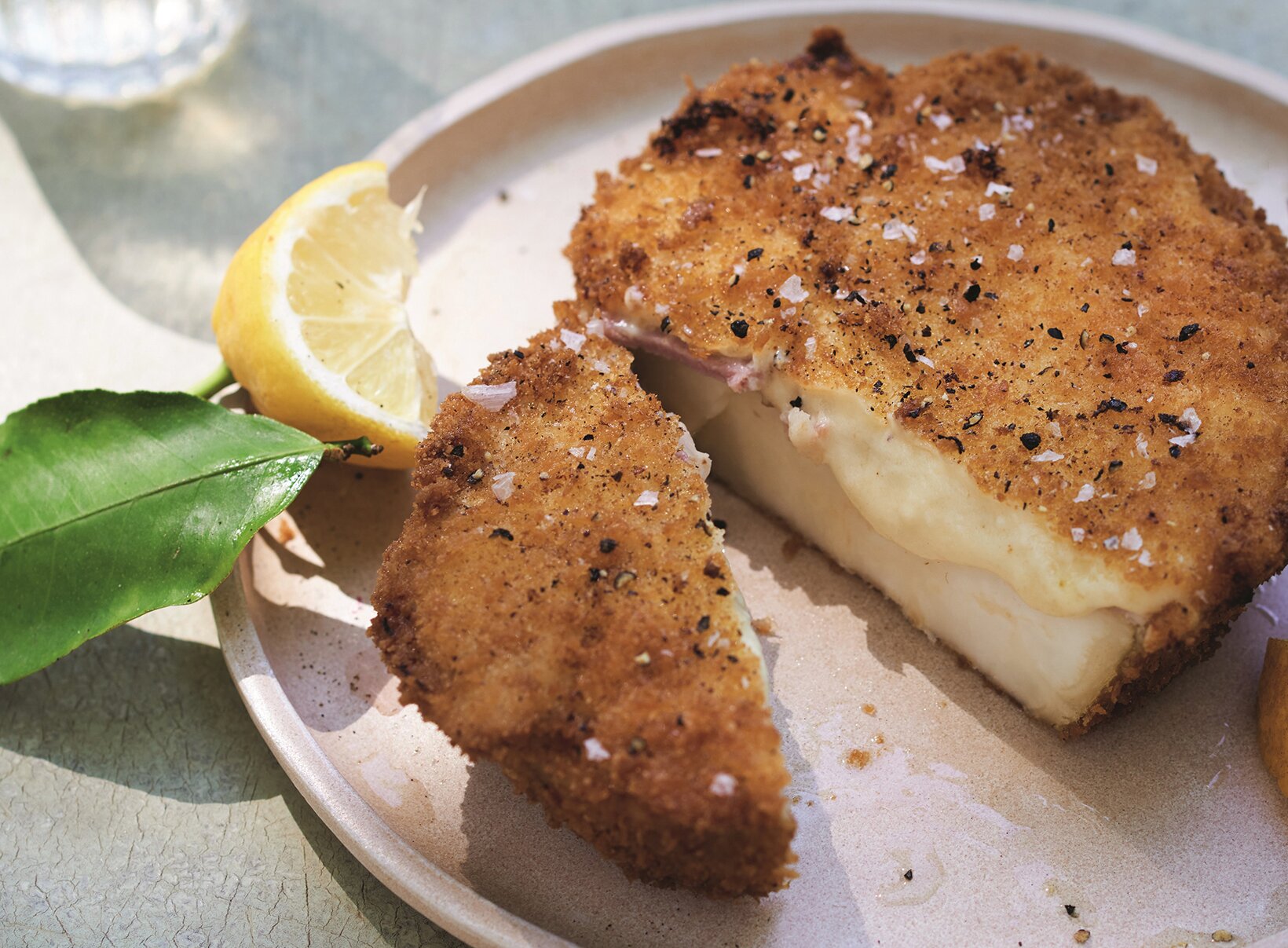Recipe of the week: Gizzi Erskine's celeriac cordon bleu
Taken from Restore: A Modern Guide to Sustainable Eating by Gizzi Erskine (HQ, £25)
On trying to remember if I’d ever actually eaten a ‘cordon bleu’ in a restaurant, I recalled a visit to a famous medical detox clinic in Austria. Being utterly fed up with the vegetable broth and ‘chewing trainers’ (don’t ask), I sneaked off to a local schnitzel restaurant and had cordon bleu!
Created in the 1940s in Switzerland, it is a cutlet of veal, pork or chicken flattened out, stuffed with ham and cheese (in some cases also a rich cheesy béchamel), folded, then breaded and fried. When I was a girl, my mum, who almost always cooked meals from scratch, would buy it from Marks & Spencer for a treat.
In a bid to eat less meat, using salt-baked celeriac as the ‘cutlet’ base is a great alternative vehicle for oozy béchamel and ham. The flavour combination of celeriac, dairy and ham is superb (think rémoulade, which is often served with ham), and this dish also nods towards the Belgian dish of roasted chicory with ham and béchamel. It is a brilliant way to showcase how we can eat a little meat and cheese, without going the whole hog.
Serves 4
- 2 free-range eggs, whisked
- 100g plain flour, seasoned with
- salt and black pepper
- 300g breadcrumbs (white or panko)
- 4 thick slices of good-quality ham
- 1 x salt-baked celeriac (see below), cooled and cut into 4x2.5cm-thick slices
- Oil, for frying
- Freshly ground black pepper
- Lemon wedges, to serve
For the béchamel
- 30g butter
- 30g plain flour
- 300ml milk
- 100g Cheddar, grated
- 30g Parmesan, grated
- Generous grating of nutmeg
- Pinch of cayenne
- Pinch of white pepper
- ½tsp English mustard powder
- Sea salt flakes
To make the béchamel, melt the butter in a saucepan over a medium heat, then add the flour and stir with a wooden spoon to form a smooth paste. Cook for a minute then pour in a quarter of the milk and beat well until smooth. Repeat until you have added all the milk, then cook over a low heat for 2-3 minutes to make a thick white sauce.
Stir in both cheeses until melted. Remove from the heat, add the nutmeg, cayenne, white pepper and mustard, and season to taste. Transfer to a heatproof container, cool to room temperature, then chill in the fridge for at least 15 minutes so it firms up.
Put the whisked egg, seasoned flour and breadcrumbs in three separate bowls.
Place one slice of ham on top of each celeriac slice, then spread two tablespoons of the cold béchamel on top in a thick, even layer. Repeat with the other three celeriac slices. Carefully dip each celeriac, ham and béchamel slice first into the seasoned flour until well coated, then in plenty of the egg and, lastly, the breadcrumbs. If the breadcrumbs don’t easily stick, use a pastry brush to add some more egg and patch up any gaps with some extra breadcrumbs. Place the celeriac slices in the fridge for at least 30 minutes.
Pour enough oil into a frying pan so that it comes up to 1cm and heat over a medium heat. Fry the celeriac slices one at a time (to avoid overcrowding the pan) for about two minutes on each side, until the breadcrumbs crisp up and turn dark golden. Remove and drain on kitchen paper. Serve with lemon wedges and a twist of black pepper.
For the salt-baked celeriac
- 3 free-range egg whites
- 1 celeriac, scrubbed well and dried
- 500g fine sea salt
Pre-heat the oven to 200ºC and line a baking tray with oiled baking parchment.
Lightly whisk the egg whites in a bowl for a few minutes to break them up and get some air into them as the base structure of the salt crust. You’re not really making a solid salt meringue, as the salt will attack the structure of the egg whites a little, but whisk in the salt and it will become a sticky but smooth paste.
Place a scoop of the salt paste in the middle of the oiled sheet of baking parchment as a base for the celeriac to sit upon. Place the celeriac on top, then pat the rest of the paste with your hands all over the celeriac, so it is completely covered. Bake in the oven for one hour and 10 minutes.
Once cooked, remove from the oven and allow to cool for a few minutes. You can tell if the celeriac is done by sticking a skewer or sharp knife in the centre, through the crust. It should be done but still relatively firm. The salt will have formed a rock-hard crust, but this will crack off easily with a few taps of the knife. Remove the crust and allow the celeriac to rest for about 10 minutes, until you can handle it. Carefully slice off the skin with a sharp knife, trim the ends, then slice across the celeriac so that you get four round steaks.
Photo: Issy Croker





















